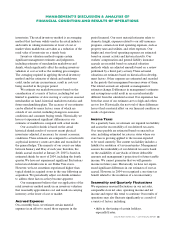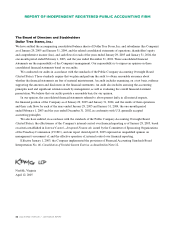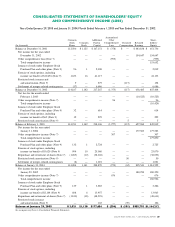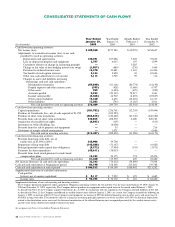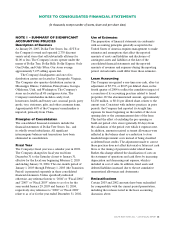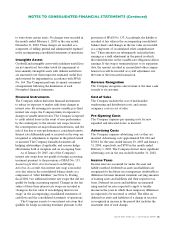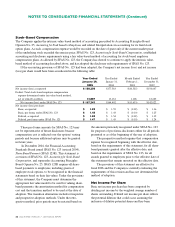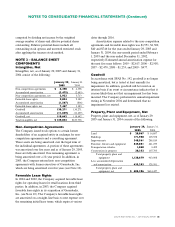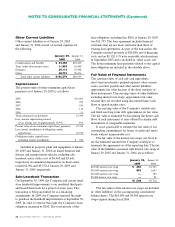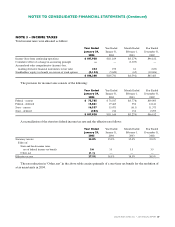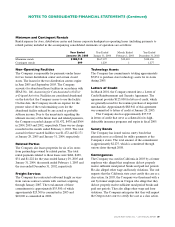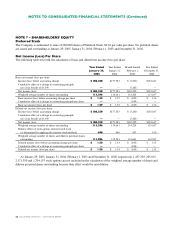Dollar Tree 2004 Annual Report Download - page 36
Download and view the complete annual report
Please find page 36 of the 2004 Dollar Tree annual report below. You can navigate through the pages in the report by either clicking on the pages listed below, or by using the keyword search tool below to find specific information within the annual report.
32 DOLLAR TREE STORES, INC. • 2004 ANNUAL REPORT
Cash and Cash Equivalents
Cash and cash equivalents at January 29, 2005 and
January 31, 2004 includes $75,885 and $54,081,
respectively, of investments in money market securities
and bank participation agreements which are valued at
cost, which approximates market. The underlying assets
of these short-term participation agreements are primarily
commercial notes. For purposes of the consolidated
statements of cash flows, the Company considers all
highly liquid debt instruments with original maturities
of three months or less to be cash equivalents.
Short-Term Investments
The Company’s short-term investments consist primarily
of government-sponsored municipal bonds and auction
rate securities. These investments are classified as
available for sale and are recorded at fair value. The
government-sponsored municipal bonds can be converted
into cash with one or seven day notice. The auction rate
securities have stated interest rates, which typically reset
to market prevailing rates every 35 days or less. The
securities underlying both the government-sponsored
municipal bonds and the auction rate securities have
longer legal maturity dates. Prior to the end of fiscal
2004, the Company classified a portion of these
investments in cash and cash equivalents due to their
liquidity. Prior period information was reclassified,
including the impact on cash flow from investing
activities, to conform to the current year presentation.
There was no impact on net income or cash flow from
operating activities as a result of the reclassification.
Merchandise Inventories
Merchandise inventories at the distribution centers are
stated at the lower of cost or market, determined on a
weighted average cost basis. Cost is assigned to store
inventories using the retail inventory method, determined
on a weighted average cost basis.
Costs directly associated with warehousing and
distribution are capitalized as merchandise inventories.
Total warehousing and distribution costs capitalized into
inventory amounted to $27,968 and $24,510 at January
29, 2005 and January 31, 2004, respectively.
Property, Plant and Equipment
Property, plant and equipment are stated at cost and
depreciated using the straight-line method over the
estimated useful lives of the respective assets as follows:
Buildings 39 years
Furniture, fixtures and equipment 3 to 15 years
Transportation vehicles 4 to 6 years
Leasehold improvements and assets held under capital
leases are amortized over the estimated useful lives of the
respective assets or the committed terms of the related
leases, whichever is shorter. Amortization is included in
“selling, general and administrative expenses”on the
accompanying consolidated statements of operations.
In the fourth quarter of 2004, the Company revised
its estimate of useful lives on certain store equipment and
distribution center assets. This change will increase net
income by approximately $3,700 in the first three
quarters of 2005 as compared to 2004.
Costs incurred related to software developed for
internal use are capitalized and amortized over three
years. Costs capitalized include those incurred in the
application development stage as defined in Statement
of Position 98-1, Accounting for the Costs of Computer
Software Developed or Obtained for Internal Use.
Impairment of Long-Lived Assets and
Long-Lived Assets to Be Disposed Of
The Company reviews its long-lived assets and certain
identifiable intangible assets for impairment whenever
events or changes in circumstances indicate that the
carrying amount of an asset may not be recoverable, in
accordance with Statement of Financial Accounting
Standards (SFAS) No. 144, Accounting for the Impairment
or Disposal of Long-Lived Assets. Recoverability of assets to
be held and used is measured by comparing the carrying
amount of an asset to future net undiscounted cash flows
expected to be generated by the asset. If such assets are
considered to be impaired, the impairment to be
recognized is measured by the amount by which the
carrying amount of the assets exceeds the fair value of the
assets based on discounted cash flows or other readily
available evidence of fair value, if any. Assets to be disposed
of are reported at the lower of the carrying amount or
fair value less costs to sell. In fiscal 2004 and 2003, the
Company recorded charges of $531 and $234, respectively,
NOTES TO CONSOLIDATED FINANCIAL STATEMENTS (Continued)



